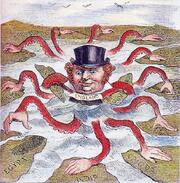10.4 - Imperialism
Western European interactions with African and Asia shifted from limited regional contacts
along the coast to greater influence and connections throughout these regions.
Competing industrialized states sought to control and transport raw materials
and create new markets across the world.
Western European interactions with African and Asia shifted from limited regional contacts
along the coast to greater influence and connections throughout these regions.
Competing industrialized states sought to control and transport raw materials
and create new markets across the world.
Imperialism can be described as when one country takes over another country for its resources socially, politically, economically, and militarily. These actions by Western European countries dominating the rest of the world can be seen in a handout called the Causes of New Imperialism. One of the best examples of this era can be seen in a map of the British Empire by 1900. Remember the phrase "The sun never sets on the British Empire."
We will cover this unit on Imperialism in geographic regions.
The first region covered will be covered using the India, the Jewel in the Crown lesson. The geographic importance of India can be seen in the Colonial rule in India map. To connect Great Britain (the mother country) to its colony in India, transportation was a key issue as seen in the lesson on the importance to the British of the Suez Canal. Imperialism was not always positive for the colonizing nation, as seen in the famous Kipling poem The White Man's Burden.
We will cover this unit on Imperialism in geographic regions.
The first region covered will be covered using the India, the Jewel in the Crown lesson. The geographic importance of India can be seen in the Colonial rule in India map. To connect Great Britain (the mother country) to its colony in India, transportation was a key issue as seen in the lesson on the importance to the British of the Suez Canal. Imperialism was not always positive for the colonizing nation, as seen in the famous Kipling poem The White Man's Burden.
The next region covered is the continent of Africa and the disputes for territories can be seen in the Berlin Conference cartoon. The Scramble for Africa lesson is the key to understanding the effects of imperialism on Africa, validated by the color map showing the Partition of Africa and the political cartoon for the Scramble for Africa. The British domination of Africa is evidenced in the famous "Cape to Cairo" cartoon where Imperialism is a "Glorious Pursuit." The effects of imperialism on African people is clearly shown on the colonial languages of Africa map and in these pictures of the British and Belgian colonial rule in Africa. Political rivalries and conflicts between European countries in Africa were common, especially in this instance which is a map showing the Boer War in South Africa. To close the section on Africa, I have included a document reading with questions on Two views of Imperialism in Africa.
China once known as the Middle Kingdom was a prime target for Western European domination and control. The unequal trading agreements between China and Western Europe led to an inevitable takeover by western powers. These events are seen in the lesson on Imperialism in China. The British used improper tactics to open the doors to western trade, as evidenced by a picture of an Opium Warehouse and a handout on the Opium Wars in China. The dynasty system will eventually fall due to Western European imperialism but one of the last rulers is seen in the portrait of the Dowager Empress Cixi.
Two other Asian regions came under Western European control. The first is an overview lesson on Imperialism in Southeast Asia that is followed by the lesson on Imperial Japan and the Meiji Restoration. Westernization led to the rise of Japan and their conquest to become a world power. The following Japanese Propaganda pictures of the Sino-Japanese War validate their emerging superiority.
